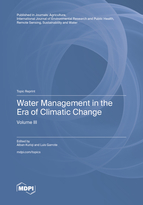Topic Menu
► Topic MenuTopic Editors


Water Management in the Era of Climatic Change

A printed edition is available here.
Topic Information
Dear Colleagues,
Water is a crucial element on Earth for all living and non-living components. Presently, climate change is an alarming issue for managing and sustaining life on Earth. Given climate change, the water resources all over the world have been drastically placed under a stressed condition, which is evident from the uneven weather patterns, droughts, floods, and cloud bursts, among others. Only three percent of the water resources on Earth are fresh and two-thirds of the freshwater is locked up in ice caps and glaciers. Of the remaining one percent, a fifth is in remote, inaccessible areas. Much seasonal rainfall in monsoonal deluges and floods cannot be easily used. At present, only about 0.08 percent of all the world's freshwater is exploited by humankind in an ever-increasing demand for sanitation, drinking, manufacturing, leisure, and agriculture. Ever-increasing water exploitation has intensively degraded freshwater ecosystems, notably rivers.
Furthermore, the climate extremes and water scarcity enhanced by climate change induce additional stress in the freshwater ecosystems and may stimulate conflicts among water users. In addition, we are aware that water is needed for several vital human activities, of which agricultural and industrial activities seem to be the primary water consumer. In the context in which we observe more frequent droughts and incidences of water scarcity in the world, water systems management requires the most advanced approaches and tools for rigorously addressing all of the dimensions involved in the sustainability of its development.
Therefore, this Topic Collection's main objective is to contribute to understanding water systems management and to provide science-based knowledge, new ideas/approaches, and solutions for water resources management. Water demand for irrigation has been steadily increasing during the last decades. However, simultaneously, other water users have been competing with agricultural sectors for water resources. Conservation of freshwater ecosystems also needs special attention through sufficient allocation of the environmental flows. In addition, in terms of projected climate change through warmer temperatures and shifting precipitation patterns, it is expected to decrease water availability and to increase water demand in many areas of the world.
Consequently, soil productivity and thus crop production could be drastically reduced. These trends raise concerns, highlighting the role of water and natural resources management, as well as their conservation for the sustainability of irrigated agriculture. How well irrigated agriculture adapts to water scarcity scenarios, particularly by increasing water use efficiency and better estimating evapotranspiration, will directly affect the future and sustainability of the sector. Therefore, we invite authors to contribute original research articles and review articles focused on different practices and experiences of water management issues.
This collection includes but is not limited to the following topics:
- Water management under climate extremes/change;
- River restoration;
- River rehabilitation;
- Freshwater ecosystem conservation;
- Environmental flows;
- Hydrologic alteration;
- Evapotranspiration;
- Irrigation scheduling;
- Water supply;
- Drip irrigation;
- Soil moisture sensors;
- Water quality;
- Heuristic methods in water management;
- Precision agriculture;
- Climate-smart irrigation tools;
- Role of GIS and RS in water management;
- Rainwater harvesting;
- Green infrastructure;
- Bioswales and rain gardens;
- Hydroponics.
Dr. Alban Kuriqi
Prof. Dr. Luis Garrote
Topic Editors
Keywords
- remote sensing
- soil moisture
- water management optimization and modeling
- ecohydrology
- ecohydraulic
- water quality
- water harvesting
- climate change
- irrigation
- evapotranspiration
- water governance
- urban floods
Participating Journals
| Journal Name | Impact Factor | CiteScore | Launched Year | First Decision (median) | APC |
|---|---|---|---|---|---|

Agriculture
|
3.6 | 3.6 | 2011 | 17.7 Days | CHF 2600 |

International Journal of Environmental Research and Public Health
|
- | 5.4 | 2004 | 29.6 Days | CHF 2500 |

Remote Sensing
|
5.0 | 7.9 | 2009 | 23 Days | CHF 2700 |

Sustainability
|
3.9 | 5.8 | 2009 | 18.8 Days | CHF 2400 |

Water
|
3.4 | 5.5 | 2009 | 16.5 Days | CHF 2600 |

MDPI Topics is cooperating with Preprints.org and has built a direct connection between MDPI journals and Preprints.org. Authors are encouraged to enjoy the benefits by posting a preprint at Preprints.org prior to publication:
- Immediately share your ideas ahead of publication and establish your research priority;
- Protect your idea from being stolen with this time-stamped preprint article;
- Enhance the exposure and impact of your research;
- Receive feedback from your peers in advance;
- Have it indexed in Web of Science (Preprint Citation Index), Google Scholar, Crossref, SHARE, PrePubMed, Scilit and Europe PMC.

